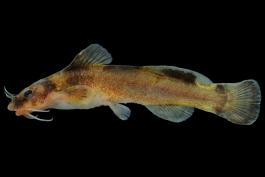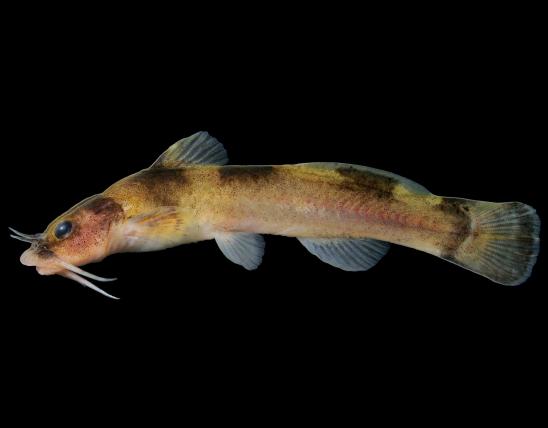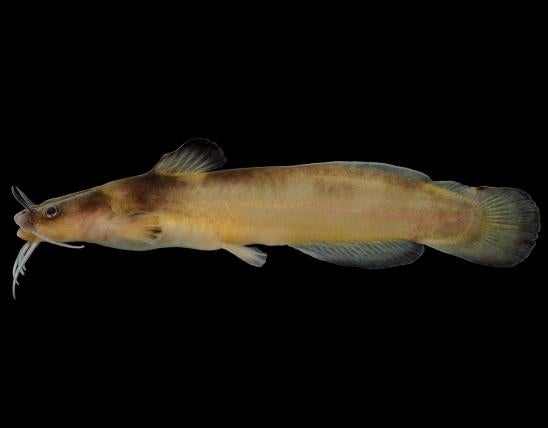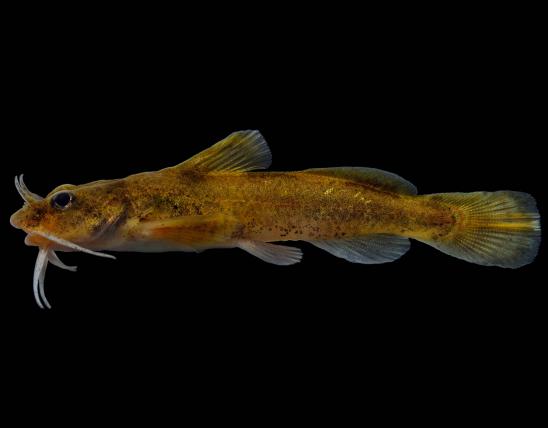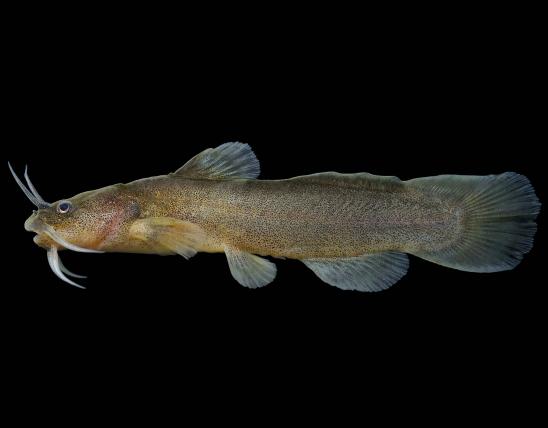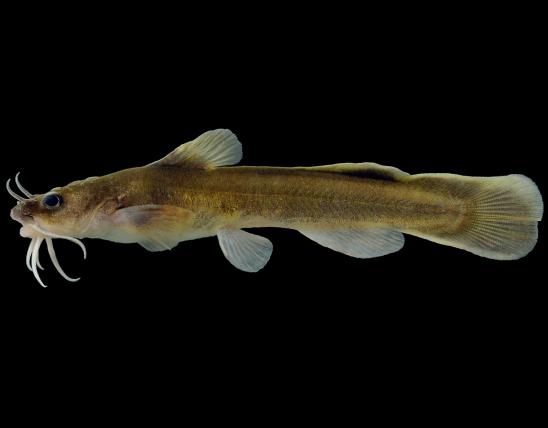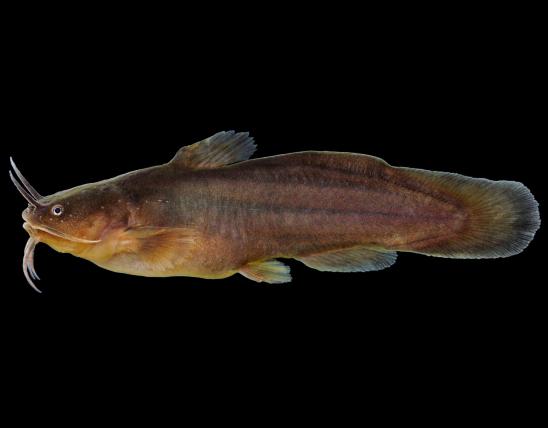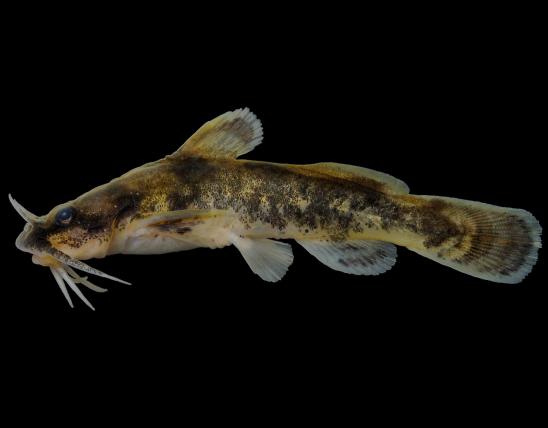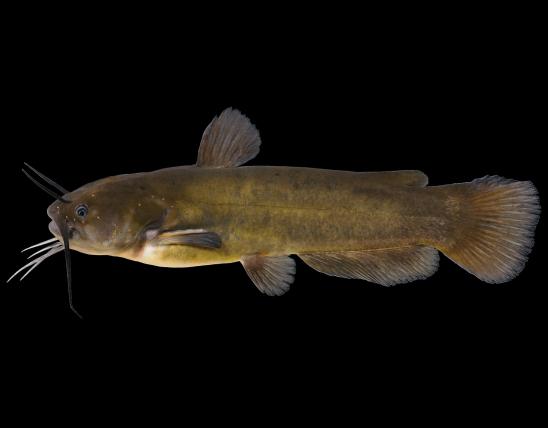
The Black River madtom occurs only in the Black and St. Francis rivers of the Ozarks of southern Missouri and northern Arkansas. The back and fins are distinctly mottled with dark blotches and bars. It is identical to the Ozark madtom, which occurs only in the upper White River system.
Madtoms, as a group, are small, secretive catfishes that most people never see. The key identifier for madtoms has to do with the adipose fin (the small, fleshy fin that is present on the midline of the back just ahead of the tail fin). In madtoms, the adipose fin forms a low, keel-like ridge without a free, flaplike lobe along the trailing edge. The adipose may be connected to the tail fin, or it may have (at most) a slight notch in between. (In our other catfishes, the adipose fin forms a free, flaplike lobe, widely separate from the tail fin.)
The Black River madtom is identical to the Ozark madtom. Both have the pectoral spine with prominent sawlike teeth along the rear margin; the upper jaw projects well beyond the lower jaw; the tooth pad on the upper jaw lacks backward extensions.
The body and fins are rather distinctly mottled with dark blotches and bars: The dark bar beneath the adipose fin usually does not reach upward to the margin of the fin. There is no broad dark bar across the base of the tail fin. The dorsal fin lacks a dark blotch toward the outer margin. The head length (from tip of snout/lips to the back edge of gills) goes more than 3.5 times into the standard length (tip of snout/lips to base of tail). The distance from the tip of the tail fin to the notch between the tail fin and adipose fin goes more than 2 times into the distance from the notch forward to the front of the dorsal fin base.
The back is light brown with 4 indistinct dark crossbars. The sides are similarly colored, with faint dark mottlings. The belly is pale yellow or creamy white. The fins are pale yellowish white with indistinct dark blotches and bars.
Most madtoms possess a mild venom that is associated with the pectoral and dorsal spines. When introduced into a puncture wound produced by the spine, the venom causes a painful reaction. The spines are often erected and locked in place when the madtom is alarmed, increasing the chance of a puncture. The venom is not considered dangerous to people, and the chances of being “spined” are not great if the possibility is kept in mind when handling a madtom. If you’ve been jabbed by a madtom spine and think you’re having a severe reaction, seek medical attention.
Similar species: The Black River madtom used to be considered the same species as the Ozark madtom (N. albater), and from naked-eye characteristics, it is impossible to tell the difference between them. They are, however, quite different genetically and in numbers of chromosomes — so different that in 2006 biologists declared them separate species. These two “cryptic species,” however, occur in separate river systems, meaning that you can ID them by geography: The Ozark madtom occurs in the upper White River system, while the Black River madtom occurs in the Black and St. Francis rivers.
There are about 30 species of madtoms (in the genus Noturus), and all occur in the central and eastern United States and nearby parts of Canada. In Missouri, 10 species of madtoms have been recorded. It can be difficult to separate the different species of madtoms using the traditional methods of fish ID (counting fin rays, for instance, or comparing ratios of body-part measurements). Noting differences in pigmentation (such as dark bars or patches) can help, but such coloration often varies by particular locality and habitat (such as amount of vegetation, turbidity, or different substrates). Color can also vary by a fish’s health, mood, breeding condition, sex, and individual genetics, and dead fish may show little coloration at all. Molecular (DNA) date is being used more and more as a way to separate the species; of course, it is not very useful in the field. Geography can be a good clue for species IDs, since different species may be restricted to certain stream systems and never occur in others.
Adult length: commonly 2½–4 inches; maximum about 5 inches.
Endemic to the Ozark Region of southern Missouri and northern Arkansas, in the Black and St. Francis rivers. The range of this species amounts to the eastern portion of what was once thought to be the entire range of the Ozark madtom.
Habitat and Conservation
Compared to our other catfishes, madtoms as a group are relatively unfamiliar to most people. They are small and secretive, and they are rarely seen unless someone is making a special effort to capture them.
A characteristic madtom of Missouri’s southeastern Ozark streams. Where it occurs, the Ozark madtom is one of the most abundant species of madtoms. It avoids headwater creeks, reaching its greatest abundance in medium-sized to moderately large Ozark streams. It inhabits the riffles and rocky pools of clear, high-gradient streams having permanent, strong flow. Sometimes it occurs in relatively shallow pools. It does not thrive in streams kept continuously cool by inflow from large springs.
During daytime, the Ozark madtom hides beneath coarse gravel and rocks. At night, it emerges to forage over the bottom in riffles and shallow gravelly pools.
Food
Black River madtoms forage over the bottom of streambeds at night, using their highly sensitive barbels to taste and touch food items. Immature midge flies and mayflies are favorite foods, along with lesser quantities of other aquatic insects, worms, as well as seeds.
Life Cycle
Breeding males have enlarged head muscles and swollen lips. Males construct nest cavities under flat rocks in riffles, raceways, or shallow pools with current. Nests with eggs and recently hatched fry appear in Ozark streams in late June and early July, and females may still hold fully developed eggs in late July. Males guard the nests, attending the eggs and fry for at least two days after hatching. They do not feed during this time. The life span may be 3 years or more.
Human Connections
Although madtoms are not useful to people as food or game, they are interesting animals that contribute to the diversity and health of the aquatic ecosystems they inhabit.
People who have aquariums understand the fascination of small fishes. Madtoms can make good aquarium subjects, although they tend to remain hidden. They usually can be coaxed into the open with food, especially under low illumination at night, when they are normally active. A benefit of madtoms is that they do not outgrow a tank the way our other native catfish do. Nongame fishes that are not otherwise protected may be collected for aquarium purposes by the holder of a fishing permit, using techniques and in numbers specified for bait collecting in the Wildlife Code of Missouri.
The species name, mayden, honors Dr. Richard L. Mayden, an ichthyologist (fish scientist) at SLU in St. Louis, Missouri.
Ecosystem Connections
By feeding on immature midges and mayflies, the Black River madtom serves as a check on the populations of those insects. The presence of stout, sawtoothed, venomous spines reminds us that many animals seek out the Black River madtom as prey.
This is one of many Missouri fishes that require the clear, flowing, gravel- or rocky-bottomed streams so characteristic of the Ozarks. Soil disturbances (such as construction or agriculture) that introduce quantities of silt into streams degrade these habitats.

